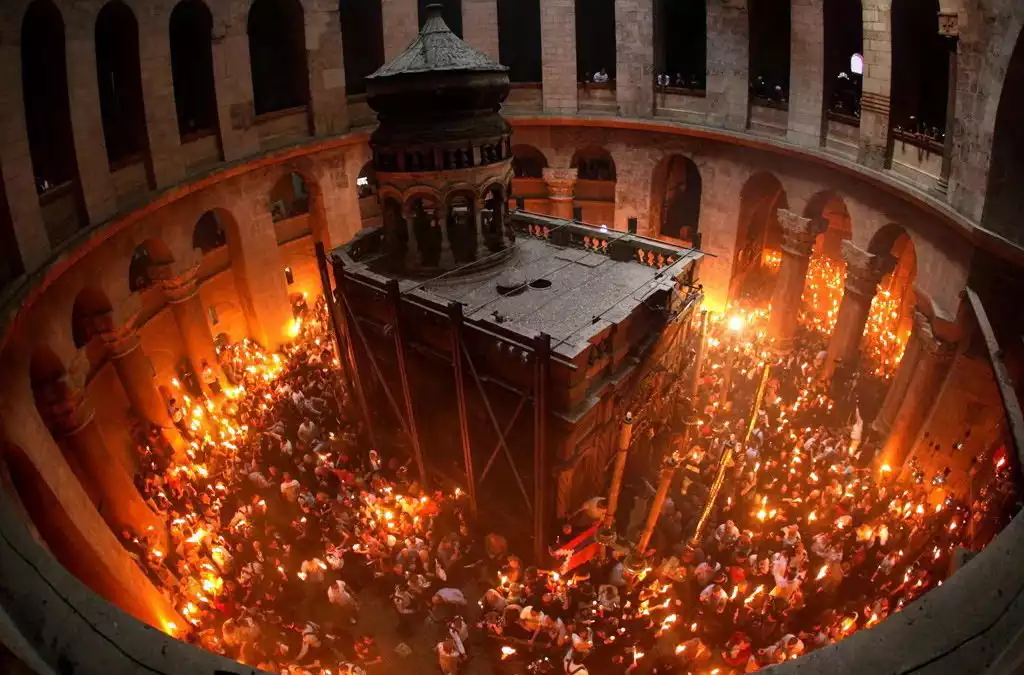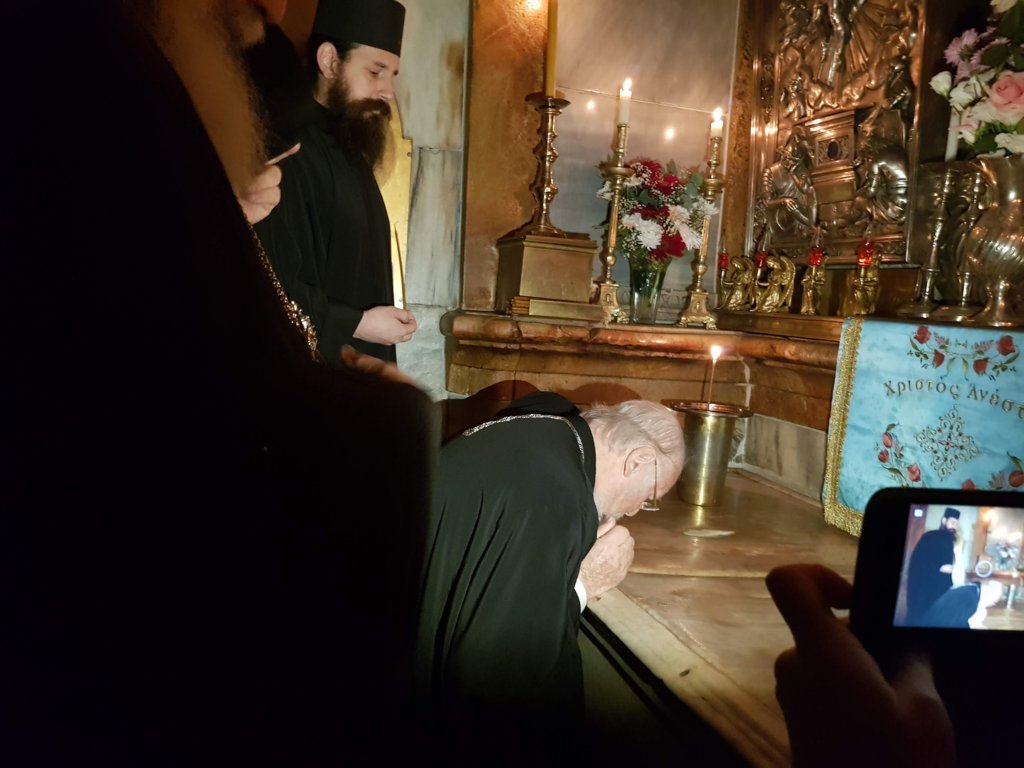
The Holy Sepulchre, revered as the site of Jesus Christ’s burial and resurrection, stands as an enduring monument of profound religious importance and deep spiritual significance in Christianity. Historically significant, this sacred site, located in the heart of the Christian Quarter of the Old City of Jerusalem, has been a pivotal and unceasing focal point of Christian pilgrimage since the 4th century. While the exact dates of the establishment of the Holy Sepulchre are debated among scholars, it is traditionally and widely linked to the reign of Constantine the Great (272-337 AD), who notably ordered the construction of the Church of the Holy Sepulchre.
Historical Background and Construction
The Holy Sepulchre’s origins intertwine deeply with early Christian history following Constantine’s momentous decision to legalize the faith in the Roman Empire. His pious mother, Helena, embarked on a pilgrimage to Jerusalem where legend holds she uncovered the True Cross and the site of Christ’s tomb in 326 AD. Moved by her discovery, Constantine commissioned the magnificent Church of the Holy Sepulchre over this sacred location, seeing its dedication just nine years later in 335 AD.
Despite its grandeur, this inaugural edifice weathered a turbulent centuries, facing cycles of destruction and reconstruction mirroring Jerusalem’s violent upheavals. Today’s incarnation largely owes its shape to Crusader builders, though subsequent generations have left their marks through restoration and embellishment. This richly layered monument synthesizes numerous eras and aesthetic currents – a living testament to the city’s diverse heritage.
Beyond its physical fabric, the Holy Sepulchre also embodies complex inter-faith relations. The site has long attracted competing Christian denominations, each claiming stewardship over different areas within its walls. This precarious power-sharing arrangement demands sensitive cooperation among the custodian communities through delicate negotiations.
Architectural Features and Artistic Significance
The Church of the Holy Sepulchre, a structure of profound architectural and artistic significance, exemplifies a blend of various styles accrued over centuries. The complex design of the church is a result of numerous reconstructions, each adding layers of history and artistry. Central to the church’s layout is the Aedicule, a small chapel housing what is believed to be the tomb of Christ. This structure, reconstructed in the early 19th century, epitomizes the amalgamation of styles, with its ornate Baroque and Byzantine influences.
The Rotunda, a significant architectural feature, houses the Aedicule. It is characterized by a large dome, which underwent restoration in the 1990s, showcasing a rich mosaic depicting Christ in Majesty. The dome’s oculus, open to the sky, allows natural light to illuminate the sacred space below, creating an ethereal atmosphere.
Another notable area is the Calvary (Golgotha), accessible by a steep staircase. It is adorned with mosaics and altars, marking the site where Christ is believed to have been crucified. The juxtaposition of the Crusader-era mosaics with the modern restorations exemplifies the church’s continuous evolution.
The church also houses numerous chapels and shrines, each associated with different denominations and moments from the Passion of Christ. These areas are adorned with intricate iconography, mosaics, and relics, contributing to the site’s religious and artistic richness. The diversity in the artistic representations within the church reflects the varied interpretations and traditions of the Christian faith.
Religious Significance and Pilgrimage
The Church of the Holy Sepulchre holds immense religious significance for Christians worldwide, symbolizing the crucifixion, burial, and resurrection of Jesus Christ. As such, it has been a major pilgrimage destination for centuries, drawing believers who seek to connect with the foundational events of their faith.
The church’s significance is highlighted during major Christian festivals, especially Easter, when the ceremony of the Holy Fire occurs. This event, believed to be a miracle, involves the spontaneous ignition of a flame in the Holy Sepulchre, symbolizing the resurrection of Christ. Pilgrims gather in large numbers to witness and partake in this profound spiritual experience.
Moreover, the Via Dolorosa, the path believed to be taken by Jesus to his crucifixion, culminates at the Holy Sepulchre, adding to its importance as a pilgrimage site. The journey along this path, retracing the Stations of the Cross, is a deeply reflective and emotional experience for many pilgrims, culminating in their arrival at the church.
The Holy Sepulchre also serves as a symbol of unity and diversity within Christianity. Despite historical conflicts and ongoing jurisdictional disputes among various Christian denominations, the church remains a shared space of worship and veneration. This coexistence, albeit complex, underscores the unifying power of faith and the shared reverence for this sacred site.
In the forthcoming chapters, we will explore the contemporary relevance of the Holy Sepulchre and its role in modern Christian discourse, as well as the challenges and conservation efforts associated with this ancient and revered monument.
Contemporary Relevance and Ecumenical Relations
In modern times, the Holy Sepulchre persists as a vital apex of Christian worship, even as it comes to symbolize a new spirit of unity among the faith’s disparate traditions. This rapprochement is embodied in the church’s cooperative administration, a radical change from its historically contentious past among warring denominations. Today, the delicate Status Quo agreement governs custody between the Greek Orthodox, Armenian Apostolic and Roman Catholic branches, with lesser roles for the Ethiopian, Coptic and Syrian Orthodox communities.
This balance of responsibility signals broader efforts towards Christian fellowship. As custodians share duties within the church, especially during seminal celebrations, commitment to mutual respect supersedes age-old theological rifts. Through such amicable cooperation in faith’s most sacred place, the Holy Sepulchre shines as a beacon of possibility for reconciliation and understanding.
Moreover, as the fulcrum point of diverse religious narratives, the church bolsters interfaith exchange in Jerusalem’s tempestuous landscape. For beyond its significance to Christianity, the Holy Sepulchre also occupies hallowed ground for Judaism and Islam. Its enduring presence honors the many cultures and creeds crystallized in the city’s stones. By commanding reverence across denominations, the church contributes to advancing the precarious yet imperative conversation around coexistence in this historically contested crucible of legend and devotion.
Conservation Efforts and Challenges
The Church of the Holy Sepulchre, while an architectural marvel, faces significant challenges in terms of preservation and conservation. The building’s ancient structure, subjected to environmental factors and the wear of constant pilgrimage, requires ongoing maintenance and restoration. The complex ownership and the need for consensus among the custodial Christian communities often complicate these efforts.
Recent restoration projects, notably the 2016-2017 restoration of the Aedicule, demonstrate successful collaborative efforts among the Christian communities and external experts. This project addressed structural and aesthetic deterioration, stabilizing the edifice and revealing hidden artistic details previously obscured.
However, broader conservation challenges remain, including moisture damage, structural integrity issues, and the need for modern facilities to accommodate the increasing number of pilgrims. Balancing the preservation of historical authenticity with the demands of contemporary usage is a constant challenge.
The future of the Holy Sepulchre will depend on continued cooperative efforts, both among the Christian custodians and with external conservation experts. The church’s preservation is crucial, not only for its religious and historical significance but also as a symbol of shared heritage and collaborative stewardship.
The Holy Sepulchre in Modern Times and Future Perspectives
As a portal between ancient tradition and contemporary resonance, the modern Holy Sepulchre persists in profound importance for global Christendom. Each year over two million pilgrims continue to find their way through its stone passages, there to connect with foundational early Christian heritage while addressing modern spiritual needs.
Yet even as it honors its seminal role down the ages, the Holy Sepulchre also looks ahead to further inclusion and accessibility. Improved facilities, digital tours and interactive guides aim to share its rich history and spiritual succor with audiences both present and far-flung. Such initiatives aspire to bring this holy jewel to Christians across the world, affirming faith across all boundaries.
This outlook also spotlights promising interfaith horizons. Ongoing ecumenical dialogue and cross-cultural cooperation around shared stewardship of the church signals hope for deepening religious harmony. As both bulwark and bridge between diverse Christian creeds and Abrahamic faiths, the Holy Sepulchre stands as an icon of unity amidst difference – one encouraging respect, understanding and reconciliation through the ages.
Bearing centuries of artistic heritage and the prayers of millions, this sacred site remains a cornerstone of Christendom and world heritage. Its enduring legacy as a font of spiritual renewal calls all Christian branches to shared responsibility for its preservation. By working together in recognition of their common ground, keepers of the Holy Sepulchre can assure its light continues to inspire future seekers following in the footsteps of the faithful departed.
References
- Biddle, Martin. “The Tomb of Christ.” Jerusalem: The Church of the Holy Sepulchre, 1999. Accessed December 16, 2023.
- Coüasnon, Charles. “The Church of the Holy Sepulchre in Jerusalem.” London: Oxford University Press, 1974.
- “Golgotha: Is the Holy Sepulchre Church Authentic?” Academia.edu, 2023. Accessed December 16, 2023.
- “Where is Golgotha, Where Jesus was Crucified?” Biblical Archaeology Society, 2023. Accessed December 16, 2023.


